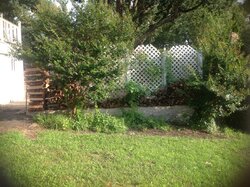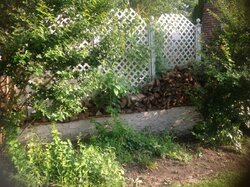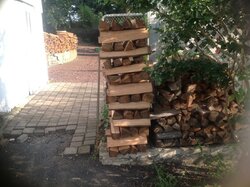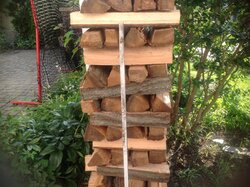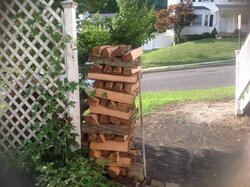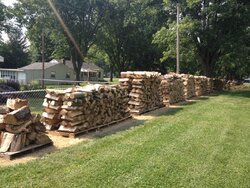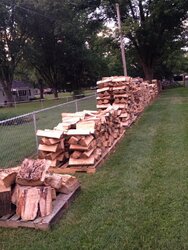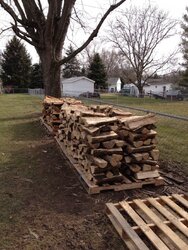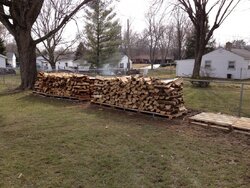Thanks guys, yes all split by hand, should I try to trim the big ones down? I'm trying to pick out solid medium sizes
What big ones?
Cribbing is not all that difficult. One thing to keep in mind is when you build a barn or house or anything like that, the first thing you do is build a foundation. Same thing with cribbing ends. That foundation can make or break it. Another difference is that you are building the foundation all the way to the top! It does not matter if you split by hand or use hydraulics, you can crib easily doing it either way.
I do tend to split lots of rectangular pieces which do help on the ends. If I don't have enough of them I'll usually go at least half way up with them then using the triangular pieces above that. I also agree that many times I'll lay only two splits per layer and then fill in later. I like to fill in with some kindling because then if I need some it is easy to get at but you can fill in with anything; just be sure whatever you put in there has to be shorter than the outside pieces.
I do not build the entire end. Most times when starting a row I'll build the ends up 3-4 layers then fill in the rest of the row. Then make 3 or 4 more layers etc. I've never found it necessary to "tie in" with longer wood as in over 50 years I've had exactly one stack fall over, so I simply do not worry about it.
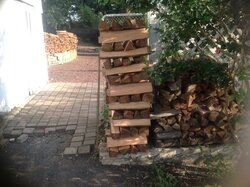
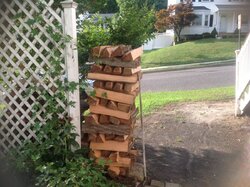
In the above stacks, both should be rebuilt. Notice that they do not go up straight. This is a prescription for disaster for sure. While it is true that sometimes I'll play around and make a layer out of level, just out of curiousity, most times after I lay that 3-4 layers, I'll then make sure everything is straight. Lean over the stack and look down on the outside. Can you see each level or is one out of sight? Perhaps one is sticking way out from the rest. Perhaps you can detect the fact that you are beginning to lean. For example, looking at the second picture above, had you looked down the outside of that end you would see that the stack is already tending to be out further than the bottom of the stack. That's okay. Now you only have that 3-4 layers to adjust before you continue stacking. In the first picture, again by standing up and leaning over the stack you will detect the lean in the stack and can straighten it. Remember, it is easier to straighten it now than after the complete stacking is finished. For those who have wondered, I do not use a square or level. I just eyeball it.
Something else that stands out in those ends are how they are built, especially the outside pieces (the inside pieces don't matter so long as they are not higher than the outside pieces). Looking at picture 1 and look at the very bottom row. Notice pieces 1, 3 and 4 (left to right). It is difficult to tell but it appears the next layer is not touching that number 1 piece. Number 3 might be a bit higher which will make it a bit tipsy. Piece #4 is put in backwards. The high part of the split needs to be on the outside and not the inside.
Now lets' look at the third row. Remember, this is the bottom of the foundation and we need to be very particular with these. Looking at row 3 vs row 1 we can see that they are sort of offset. They should have moved a couple inches to the left. Again, that first piece on the left looks like a dummy. That is, it appears the next row does not sit on this piece at all. A weak spot. Look at the middle 2 pieces. Are they too big? Look at the piece on the right. You can see it is not sitting directly on the piece under it. While here, look at the very next row on top of it. Can you see those also are shifted a bit to the right? This should give you a good idea of our thinking.
One more thing. It appears you want to make another row at a right angle from the cribbed one. This is fine but that row has to be cribbed also. If it is just leaning on the other cribbed end, you have two forces against that crib and therefore it could become a weakness. So more cribbing is in order.
Finally, in picture #2 you can really tell what you have by setting a straight edge up there. Build a good foundation and the house has a better chance of lasting a long, long time.
One more thing. You don't need much but it is a good idea when you are filling in between the two ends that you make the middle of the row a bit higher than the ends. This way when you cover it and it rains, the rain should flow off the cover rather than sitting there. In other words, you sort of make a pitch to the roof.
I hope this helps but if I have not worded it correctly, please ask about it.
